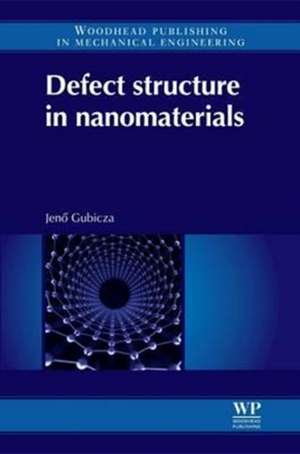Defect Structure in Nanomaterials
Autor J Gubiczaen Limba Engleză Paperback – 19 aug 2016
- Gives in-depth, physically based explanations for the relationships between the defect structure and mechanical properties of nanomaterials
- Covers a wide range of nanomaterials including metals; alloys; ceramics; diamond; carbon nanotubes and their composites
- Provides a detailed characterization of the lattice defect structure in nanomaterials
Preț: 985.73 lei
Preț vechi: 1083.22 lei
-9% Nou
Puncte Express: 1479
Preț estimativ în valută:
188.64€ • 196.22$ • 155.74£
188.64€ • 196.22$ • 155.74£
Carte tipărită la comandă
Livrare economică 07-21 aprilie
Preluare comenzi: 021 569.72.76
Specificații
ISBN-13: 9780081016602
ISBN-10: 0081016603
Pagini: 388
Dimensiuni: 156 x 234 x 20 mm
Greutate: 0.54 kg
Editura: ELSEVIER SCIENCE
ISBN-10: 0081016603
Pagini: 388
Dimensiuni: 156 x 234 x 20 mm
Greutate: 0.54 kg
Editura: ELSEVIER SCIENCE
Cuprins
List of figures
List of tables
Preface
About the author
Chapter 1: Processing methods for nanomaterials
Abstract:
1.1 Processing of bulk nanomaterials by severe plastic deformation
1.2 Processing of nanomaterials by powder metallurgy
1.3 Production of nanomaterials by electrodeposition
1.4 Nanocrystallisation of bulk amorphous alloys
Chapter 2: Defect structure in bulk nanomaterials processed by severe plastic deformation
Abstract:
2.1 Evolution of dislocation structure and grain size during SPD-processing
2.2 Comparison of defect structures formed by different routes of bulk SPD
2.3 Maximum dislocation density and minimum grain size achievable by SPD of bulk metallic materials
2.4 Excess vacancy concentration due to SPD
Chapter 3: Defect structure in low stacking fault energy nanomaterialsm
Abstract:
3.1 Effect of low stacking fault energy on cross-slip and climb of dislocations
3.2 Defect structure developed in SPD-processed low stacking fault energy pure Ag
3.3 Effect of low stacking fault energy on defect structure in ultrafine-grained alloys
3.4 Grain-refinement mechanisms in low stacking fault energy alloys
Chapter 4: Defects in nanomaterials processed by powder metallurgy
Abstract:
4.1 Development of defect structure during milling
4.2 Defect structure in nanopowders produced by bottom-up approaches
4.3 Effect of consolidation conditions on microstructure of sintered metals
4.4 Defect structure in metals sintered from blends of powders with different particle sizes
4.5 Evolution of microstructure during consolidation of diamond and ceramic nanopowders
Chapter 5: Correlation between defect structure and mechanical properties of nanocrystalline materials
Abstract:
5.1 Effect of grain size on deformation mechanisms in fcc and hcp nanomaterials
5.2 Breakdown of Hall-Petch behaviour in nanomaterials
5.3 Correlation between dislocation structure and yield strength of ultrafine-grained fcc metals and alloys processed by severe plastic deformation
5.4 Defect structure and ductility of nanomaterials
5.5 Influence of sintering conditions on strength and ductility of consolidated nanomaterials
Mechanical behaviour of materials sintered from blends of powders with different grain sizes
Chapter 6: Defect structure and mechanical properties of metal matrix-carbon nanotube composites
Abstract:
6.1 Processing of metal matrix- carbon nanotube composites
6.2 Morphology of CNTs and porosity in nanotube composites
6.3 Defect structure of metal-CNT composites
6.4 Correlation between defect structure and mechanical properties
Chapter 7: Thermal stability of defect structures in nanomaterials
Abstract:
7.1 High-temperature thermal stability of nanomaterials
7.2 Stability of nanostructured Cu during storage at room temperature
7.3 Self-annealing in nanostructured silver: the significance of a very low stacking fault energy
Chapter 8: Relationship between microstructure and hydrogen storage properties of nanomaterials
Abstract:
8.1 Fundamentals of hydrogen storage in solid state materials
8.2 Microstructure and hydrogen storage in nanomaterials processed by severe plastic deformation
8.3 Change of defect structure during dehydrogenation-hydrogenation cycles
8.4 Effect of defects on hydrogen storage properties of carbon nanotubes
Appendix: characterisation of defect structure by x-ray diffraction line profile analysis
Index
List of tables
Preface
About the author
Chapter 1: Processing methods for nanomaterials
Abstract:
1.1 Processing of bulk nanomaterials by severe plastic deformation
1.2 Processing of nanomaterials by powder metallurgy
1.3 Production of nanomaterials by electrodeposition
1.4 Nanocrystallisation of bulk amorphous alloys
Chapter 2: Defect structure in bulk nanomaterials processed by severe plastic deformation
Abstract:
2.1 Evolution of dislocation structure and grain size during SPD-processing
2.2 Comparison of defect structures formed by different routes of bulk SPD
2.3 Maximum dislocation density and minimum grain size achievable by SPD of bulk metallic materials
2.4 Excess vacancy concentration due to SPD
Chapter 3: Defect structure in low stacking fault energy nanomaterialsm
Abstract:
3.1 Effect of low stacking fault energy on cross-slip and climb of dislocations
3.2 Defect structure developed in SPD-processed low stacking fault energy pure Ag
3.3 Effect of low stacking fault energy on defect structure in ultrafine-grained alloys
3.4 Grain-refinement mechanisms in low stacking fault energy alloys
Chapter 4: Defects in nanomaterials processed by powder metallurgy
Abstract:
4.1 Development of defect structure during milling
4.2 Defect structure in nanopowders produced by bottom-up approaches
4.3 Effect of consolidation conditions on microstructure of sintered metals
4.4 Defect structure in metals sintered from blends of powders with different particle sizes
4.5 Evolution of microstructure during consolidation of diamond and ceramic nanopowders
Chapter 5: Correlation between defect structure and mechanical properties of nanocrystalline materials
Abstract:
5.1 Effect of grain size on deformation mechanisms in fcc and hcp nanomaterials
5.2 Breakdown of Hall-Petch behaviour in nanomaterials
5.3 Correlation between dislocation structure and yield strength of ultrafine-grained fcc metals and alloys processed by severe plastic deformation
5.4 Defect structure and ductility of nanomaterials
5.5 Influence of sintering conditions on strength and ductility of consolidated nanomaterials
Mechanical behaviour of materials sintered from blends of powders with different grain sizes
Chapter 6: Defect structure and mechanical properties of metal matrix-carbon nanotube composites
Abstract:
6.1 Processing of metal matrix- carbon nanotube composites
6.2 Morphology of CNTs and porosity in nanotube composites
6.3 Defect structure of metal-CNT composites
6.4 Correlation between defect structure and mechanical properties
Chapter 7: Thermal stability of defect structures in nanomaterials
Abstract:
7.1 High-temperature thermal stability of nanomaterials
7.2 Stability of nanostructured Cu during storage at room temperature
7.3 Self-annealing in nanostructured silver: the significance of a very low stacking fault energy
Chapter 8: Relationship between microstructure and hydrogen storage properties of nanomaterials
Abstract:
8.1 Fundamentals of hydrogen storage in solid state materials
8.2 Microstructure and hydrogen storage in nanomaterials processed by severe plastic deformation
8.3 Change of defect structure during dehydrogenation-hydrogenation cycles
8.4 Effect of defects on hydrogen storage properties of carbon nanotubes
Appendix: characterisation of defect structure by x-ray diffraction line profile analysis
Index
Recenzii
"Serves as a useful reference for academics, materials and physics researchers, materials, mechanical and physics engineers, professional in related industries with nanomaterials and nanotechnology." --International Journal of Materials Engineering Innovation





